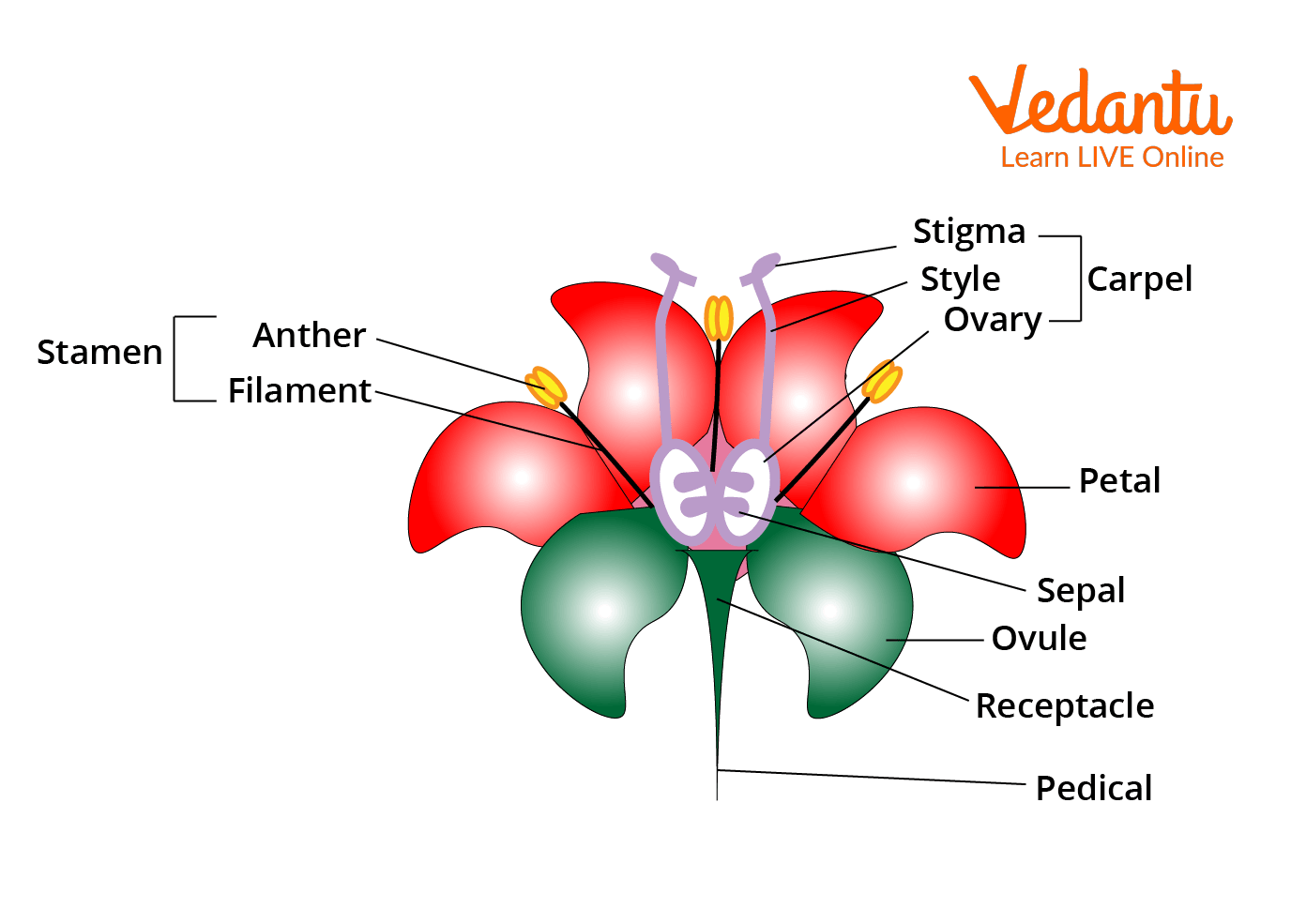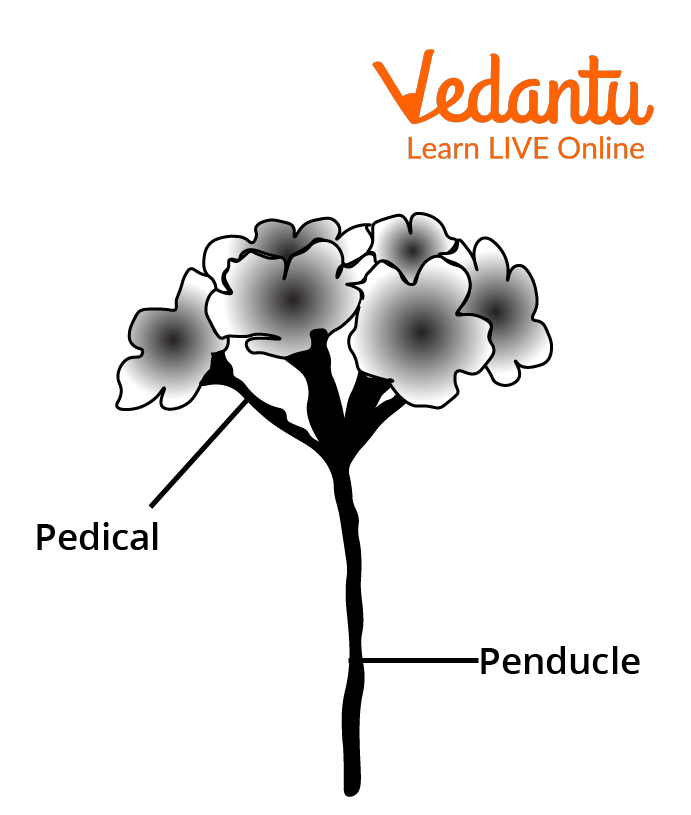Why Are Pedicels Important in Plant Biology?
The plant group Angiosperms consists of flowering plants that have a structure called a pedicel in their flowers. The pedicel in a flower is a part of these plants' inflorescence (cluster of flowers) and can be found at the base of the antenna. It is a large globular structure that attaches the flower to its base. Flowers can either be simple or composite. A simple flower always has one pedicel that carries a single flower. On the other hand, an inflorescence has the main stalk or the peduncle that holds several pedicels, each carrying a single flower.
What is Pedicel?

Parts of a Flower Indicating Pedicel
A pedicel is the stalk that supports a single flower. It creates a connection between the flower and the inflorescence. The inflorescence contains more than one flower and forms the whole plant, whereas a singular branch from the inflorescence is the pedicel. A flower with a pedicel is known as a pedicellate flower. Rose and Hibiscus are pedicellate flowers, and the pedicel in these flowers is clearly visible. You won't be able to look at the pedicel of a sunflower because this flower arises directly from the stem of the plant.
Pedicel and Peduncle

Pedicel and Peduncle
Kingdom Plantae has a group of phylum called Angiosperms which represents flowering plants. This group has many different types of flowers that can be divided into many different criteria. This group of plants contains flowering plants that consist of different types of inflorescence and flowers, such as simple flowers and composite flowers.
Pedicel: Pedicel can clearly be understood in a simple flower as it is the stalk that carries one flower.
Peduncle: In a cluster of flowers known as the inflorescence, there is a main stalk called a peduncle that holds numerous pedicels with one flower each. Peduncle is more of a support for inflorescence. It arises from the stem in order to support the numerous pedicels and flowers. This peduncle also supports the fruit when the flower matures.
Difference Between Pedicel and Peduncle
Function of Pedicel
A pedicel is a short flower stalk that holds up one single flower of an inflorescence (cluster of flowers). Pedicels support the flower and form a connection between the flower and the plant. There are many more functions carried out by the pedicel, such as:
It exposes the flower in the right direction, that is, exposing it to the sun and the wind, which helps in the overall development of the plant and the flower.
It helps them be in a position where their aroma and colour attract insects and birds easily. This helps the flowers in the process of pollination.
These also help in providing the flower with the right kind of nutrition through the plant.
Pedicellate Flower Example
Based on the presence or absence of pedicels in a flower, these can be divided into two kinds: pedicellate flowers and sessile flowers. These both are described below along with their examples.
Pedicellate Flowers: These are the flowers that have pedicels that support all other flowers. Some of the common examples of pedicellate flowers include hibiscus, rose, etc.
Sessile Flowers: These are those flowers that do not have pedicels, and the flowers in these plants are found to either be solitary or in an inflorescence. Sessile flowers are present in the spike and spadix kinds of inflorescences. Some of the common examples of sessile flowers that are found in India include Achyranthes, Saffron, etc.
Summary
A stalk or stem known as the pedicel holds a single flower in place. It joins the inflorescence with the lone bloom. Usually, pedicellate blooms exhibit it (e.g., Rose). Sessile flowers are those that lack pedicels (e.g., Sunflower).
Pedicels have the dual purposes of exposing flowers to the wind and sun as well as positioning them so that pollinating insects can be attracted to them more easily by their perfume and colour.


FAQs on Pedicel in Plants: Definition and Function
1. What is the difference between a pedicel and a petiole?
A petiole is the stalk of the leaf, that is, it is the stalk that attaches the blade of the leaf to the stem and supports it in terms of nutrition and other needs. The pedicel is the flower stalk and attached to the single flower within the inflorescence, or the cluster of flowers. Both of these are a type of stems present in a plant that have different roles to play. Petioles are associated with the leaves, whereas a pedicel is associated with the individual flower of the inflorescence.
2. How important is the chapter ‘Sexual Reproduction in Plants’ for Class 10th Boards?
The chapter ‘Sexual Reproduction in Plants’ is a very important chapter from the point of view of boards. There are numerous questions asked in this chapter everywhere. These questions can be about the structure and functions of different parts or about the types of reproduction carried out by different types of plants. The chapter has to be covered in detail and can prove to be very useful for the students in their examinations.
3. What are the other structures of flowers discussed in the chapter?
The chapter talks about the Angiosperms, which is the group of Kingdom Plantae. This chapter will include parts of plants as well as the structure and functions of flowers and their parts as well. This can include the study of the types of inflorescence, branching types, types of reproduction, the structure of a leaf and the functions that these parts are responsible for. The chapter also talks about different types of pollination that happen through a flower.










